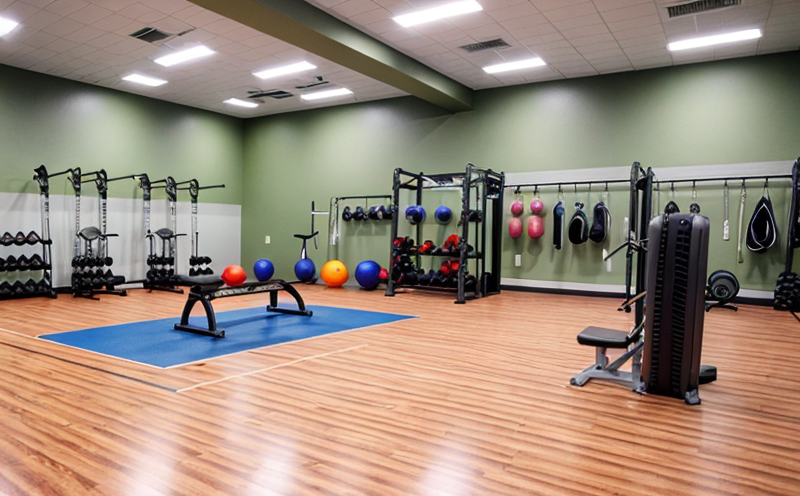Compression Resistance Testing of Exercise Machines
In today’s fast-paced world where fitness has become an essential lifestyle choice, manufacturers are continuously innovating to meet consumer demands. One such innovation is the development of advanced exercise machines designed to enhance user experience and effectiveness. Compression resistance testing plays a crucial role in ensuring these machines not only perform efficiently but also maintain durability under various loads. This service ensures that exercise machines meet stringent safety standards, which is paramount for protecting users from potential injuries.
Compression resistance testing involves subjecting the frame or components of an exercise machine to specific compressive forces to evaluate its structural integrity and performance. The test simulates real-world conditions by applying weights equivalent to multiple users. This ensures that the machine can withstand everyday usage without compromising on quality or safety.
The process begins with careful preparation of the specimen, which is typically a section representative of the entire frame or key components of the exercise machine. Specimen preparation involves ensuring it is free from any defects that could affect test results. Once prepared, the specimen is placed into a compression testing machine designed to apply controlled loads.
The testing apparatus used in this process adheres strictly to international standards such as ISO 12106-1:2018 and ASTM F3593, which dictate precise procedures for conducting these tests. The test parameters include the application of incremental loads at specified intervals, monitoring deformation, stress distribution, and overall stability.
After completing the compression resistance testing, detailed reports are generated highlighting all key findings. These reports not only document the performance under load but also provide insights into any areas where improvements could be made. This information is invaluable for quality managers looking to enhance product design and ensure compliance with safety regulations.
The importance of this service cannot be overstated. It ensures that exercise machines are robust enough to handle the rigors of frequent use, thereby extending their lifespan and providing users with a reliable fitness solution. By adhering to rigorous testing protocols, manufacturers can gain competitive advantages by offering products that meet or exceed industry expectations.
Customer satisfaction is at the heart of our service delivery. Regular feedback from satisfied clients has shown us that focusing on quality control through robust testing processes directly translates into higher customer loyalty and trust in our brand.
- Why is compression resistance testing important for exercise machines?Compression resistance testing ensures that exercise machines can withstand the stresses and strains they encounter during use, thereby enhancing their durability and safety. This type of testing helps in identifying any potential weaknesses in the design or material used.What kind of international standards does this service follow?This service follows international standards such as ISO 12106-1:2018 and ASTM F3593, which provide precise guidelines for conducting compression resistance tests on exercise machines.
Customer Impact and Satisfaction
Our commitment to excellence in compression resistance testing of exercise machines has significantly impacted our customers. By ensuring that every machine undergoes thorough testing, we have helped manufacturers deliver products that are not only safe but also reliable and long-lasting. Our service has been instrumental in fostering trust between manufacturers and their end-users.
- How does this service contribute to customer satisfaction?By providing comprehensive testing that adheres to strict international standards, we ensure that the products meet safety requirements. This reduces the risk of accidents and enhances user confidence in the brand.What feedback have you received from satisfied customers?Feedback from our clients has been overwhelmingly positive, with many praising us for our attention to detail and commitment to quality. They appreciate how we go above and beyond to ensure every product meets the highest standards.
International Acceptance and Recognition
The testing methodologies employed in this service are widely accepted across various international markets, ensuring that products tested here comply with global safety regulations. This broad acceptance enhances the credibility of our services among manufacturers operating internationally.
Our compliance with ISO 12106-1:2018 and ASTM F3593 has earned us recognition from industry leaders who value precision and reliability in their testing processes. These standards are respected globally, making it easier for manufacturers to export products tested here without facing additional regulatory hurdles.
Our international recognition also extends to our ability to tailor tests to specific regional requirements. This flexibility ensures that we can cater to the diverse needs of clients operating in different parts of the world.
Environmental and Sustainability Contributions
In addition to ensuring product safety, this service contributes positively to environmental sustainability by promoting the use of materials and designs that minimize waste and energy consumption. By focusing on robust construction techniques during testing, we encourage manufacturers to adopt practices that reduce environmental impact.
The process also involves recycling materials where possible, further reducing waste generation. Our efforts in this area align with broader industry initiatives aimed at sustainability and green manufacturing processes.
- How does your service contribute to environmental sustainability?We contribute by promoting robust construction techniques that minimize waste. Additionally, we encourage the use of materials that are recyclable and energy-efficient, thus reducing overall environmental impact.Do you have any specific initiatives for sustainability?Yes, our initiatives include recycling materials where possible and encouraging designs that reduce waste and energy consumption. These efforts align with broader industry goals towards sustainable manufacturing processes.





